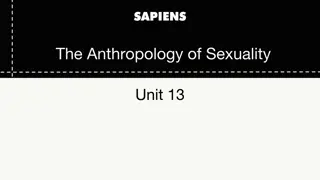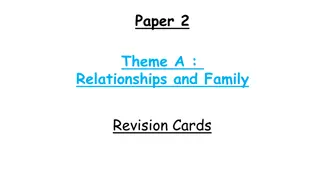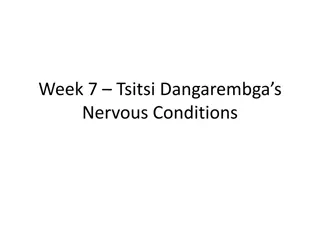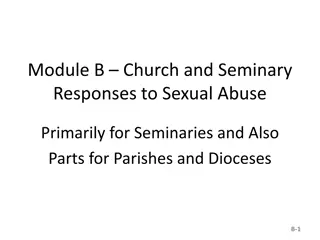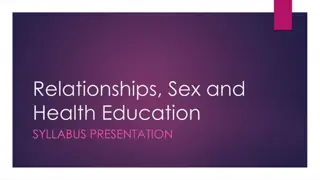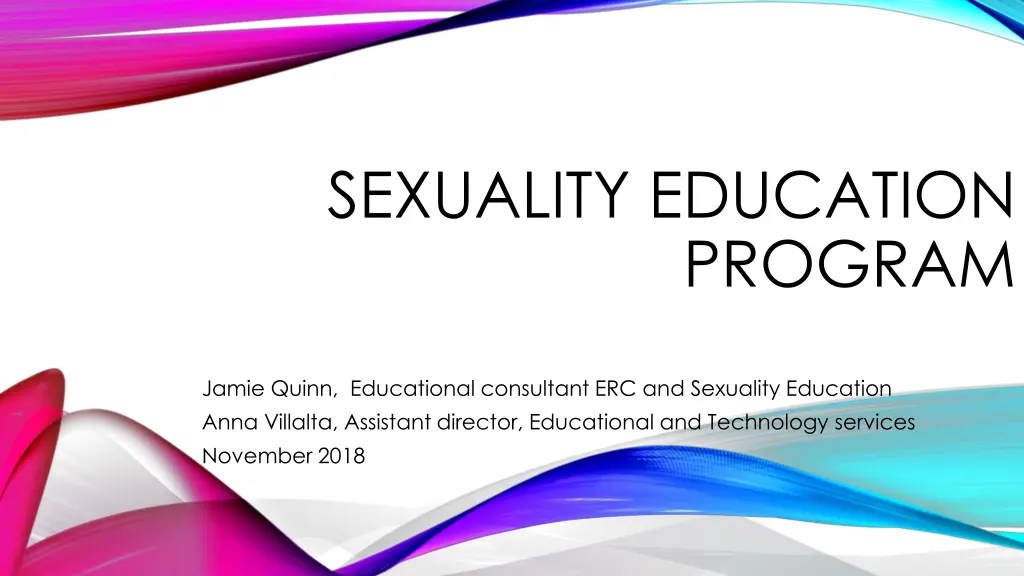
Understanding Sexuality Education: Importance and Implementation
Delve into the difference between sex, sexuality, and sexuality education. Explore the goals of the MEES Sexuality Education Program, parental and school responsibilities, and the comprehensive approach to teaching about human sexuality. Learn why students need to be educated on sexuality for promoting healthy relationships, preventing violence, and respecting diversity.
Download Presentation

Please find below an Image/Link to download the presentation.
The content on the website is provided AS IS for your information and personal use only. It may not be sold, licensed, or shared on other websites without obtaining consent from the author. If you encounter any issues during the download, it is possible that the publisher has removed the file from their server.
You are allowed to download the files provided on this website for personal or commercial use, subject to the condition that they are used lawfully. All files are the property of their respective owners.
The content on the website is provided AS IS for your information and personal use only. It may not be sold, licensed, or shared on other websites without obtaining consent from the author.
E N D
Presentation Transcript
SEXUALITY EDUCATION PROGRAM Jamie Quinn, Educational consultant ERC and Sexuality Education Anna Villalta, Assistant director, Educational and Technology services November 2018
AGENDA The difference between sex, sexuality, and sexuality education Goals of MEES Sexuality Education Program Overview of the MEES Sexuality Education content Parent and school roles and responsibilities Implementation of the compulsory content
THE DIFFERENCE BETWEEN SEX, SEXUALITY, AND SEXUALITY EDUCATION Sex refers to whether or not a person is male or female. OR to distinguish whether a person has a penis or vagina. Sex is also commonly used as an abbreviation to refer to sexual intercourse.
THE DIFFERENCE BETWEEN SEX, SEXUALITY, AND SEXUALITY EDUCATION sexuality includes Sexuality is intimacy The total expression of who you are as a human being love It begins at birth and ends at our death values affection There is no right or wrong, it s about what s right for you
THE DIFFERENCE BETWEEN SEX, SEXUALITY, AND SEXUALITY EDUCATION Sexuality Education is A progressive and constant learning of human sexuality; Informing, bringing students to reflect and express themselves, providing guidance and clear messages about sexuality and healthy relationships.
COMPREHENSIVE SEXUALITY EDUCATION
WHY OUR STUDENTS NEED TO LEARN ABOUT SEXUALITY Promoting egalitarian relationships Preventing sexual assault Preventing violence Promoting a healthy body image Respecting sexual & gender diversity Being aware of the sexualilzation of public space Preventing STBBIs and pregnancy
I am able to set appropriate boundaries. I am able to make myself better understood if I need to report inappropriate touching to a trusted adult. I am comfortable with my body and my sexuality. I can talk effectively with my friends, family and trusted adults about my needs and feelings. I know my body and how it functions. I am able to form and maintain healthy relationships. I understand the risks, responsibilities, and consequences of sexual behavior and act responsibly. Sexuality Education Program GOALS I can appreciate myself as being unique. .
THEMES AND LEARNING CONTENT MEES detailed content
SEXUAL GROWTH AND BODY IMAGE Elementary: Identifying, understanding, and becoming aware of the physical and psychological changes associated with growing up Secondary: Reflecting on the advantages of having a positive body image
COMPREHENSIVE VIEW OF SEXUALITY Elementary: Children understand what sexuality is through all dimensions Secondary: Adolescents are becoming aware and gradually adopting new roles and behaviors related to their sexuality
IDENTITY GENDER STEREOTYPES AND ROLES, AND SOCIAL NORMS Elementary: Identifying and analyzing gender roles and stereotypes, and making connections with gender inequalities. Secondary: Recognizing and analyzing the role of puberty and their influence on gender identity, in the public space.
PREGNANCY AND BIRTH Elementary : Understanding the phenomenon of conception and fetal development in the uterus STBBI s AND PREGNANCY Secondary: Take responsibility of sexual and reproductive health Identify risks of STBBI s Understand importance of contraception
SEXUAL ASSAULT AND SEXUAL VIOLENCE Elementary: To recognize different forms of sexual assault and ways of preventing and protecting themselves. Secondary: To reflect, understand and recognizing situations of sexual assault or sexual violence.
SEXUAL BEHAVIOR Secondary: Becoming aware of factors that are important to sustaining emotional and sexual intimacy.
EMOTIONAL AND ROMANTIC LIFE Elementary: Recognizing and expressing feelings, love and friendship and understanding how behaviors can affect interpersonal relationships Secondary: Becoming aware of the feelings of love and attraction in relationships and understanding meaningful healthy relationships
ROLES AND RESPONSIBILITIES Parents or guardians responsibilities: educating their children while respecting their values and taking their personalities into account Children learn: different ways of living and expressing themselves interact with different people; receive and express affection, love and empathy
ROLES AND RESPONSIBILITIES Parent roles: Act as models Influence their children s attitudes and behaviors. Create relationships of trust that allows their children to ask questions that are of concern. Are in a position to fulfill their role in sexuality education in a straightforward and honest manner.
ROLES AND RESPONSIBILITIES School responsibilities: provide facts a social environment where students interact opportunities to learn how to live in society: friendships, romantic relationships, egalitarian relationships.
ROLES AND RESPONSIBILITIES Events related to students sexuality occur on a daily basis in schools Wassim, a kindergarten student who has just welcomed a little brother, asks his teacher questions about where babies come from. Maude tells her daycare educator that a student pulled his pants down in front of the other students. Justin, an Elementary 2 student, is in love. He asks his teacher if he can have two girlfriends.
IMPLEMENTATION Students will receive 5 to 15 hours of sexuality education per year Elementary 5-10 hours Secondary 10-15 hours Delivered by classroom teacher in collaboration with: School nurse, social worker, Board professional; guidance counselor, spiritual animator , psychologist, Community organizations
GRADUAL IMPLEMENTATION Program will be taught between February and June. Parents and Governing Board shall be informed of themes and learning content through correspondence from the school. Governing board will be informed about the details of implementation. The Sexuality Education Curriculum Plan will be shared with all parents. Sexuality Education Curriculum Plan
LEARNING CONTENT IN SEXUALITY EDUCATION


